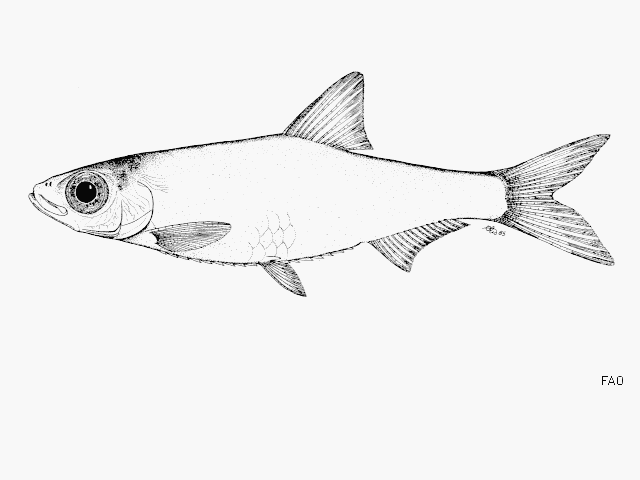|
Dorsal spines (total): 0-0; Dorsal soft rays (total): 14-16; Anal spines: 0-0; Anal soft rays: 17-19; Vertebrae: 38-39. Diagnosis: Body slender or moderate, depth about 25% of standard length; scutes a little behind isthmus, very strongly keeled, 9-10 pre-pelvic and 7-9 post-pelvic scutes; lower jaw very slightly projecting, toothless; no teeth on premaxillae or maxillae; posterior supra-maxilla as deep as maxilla blade and with long slender anterior shaft; lower gillrakers 20-23; pelvic fin with 1 unbranched and 6-7 branched rays, its insertion just below dorsal fin origin; anal fin rays 17-19; scales in lateral series 34-35 (Ref. 188, 94752). It differs from Nannothrissa parva in having fewer gillrakers, 20-23 vs. 24-31, fewer anal fin rays, 17-19 vs. 20-23, and fewer scales in lateral series, 34-35 vs. 35-40 (Ref. 188, 94752).
Description: Body depth about 25% of standard length; caudal peduncle 1 to 1.18 times as long as deep (Ref. 188, 94752). Number of lower gillrakers 20-23 (Ref. 188, 28136, 94752). Dorsal fin with 14-16 rays; anal fin with 17-19 rays; pectoral fin with 13 rays; pelvic fin with 1 unbranched and 6-7 branched rays, its insertion just below dorsal fin origin (Ref. 188, 94752). Scales in longitudinal series 34-35 (Ref. 188, 28136, 94752). Ventral scutes well developed; 9-10 pre-pelvic scutes, with 1 pre-pectoral scute without ascending arms and 9 pre-pelvic scutes with ascending arms, and 7-8 post-pelvic scutes with ascending arms, sometimes followed by 1 scute without ascending arms (Ref. 188, 94752). Number of vertebrae 38-39 (Ref. 94752).
Colouration: Silvery coloured, with a faint black spot at the base of the caudal fin, a series of small black dots at the origin of the anal rays, a blackish occiput and some small spots on the opercular region (Ref. 94752). Living specimens are characterized by a pronounced bluish reflection of the whole body (Ref. 94752). |

